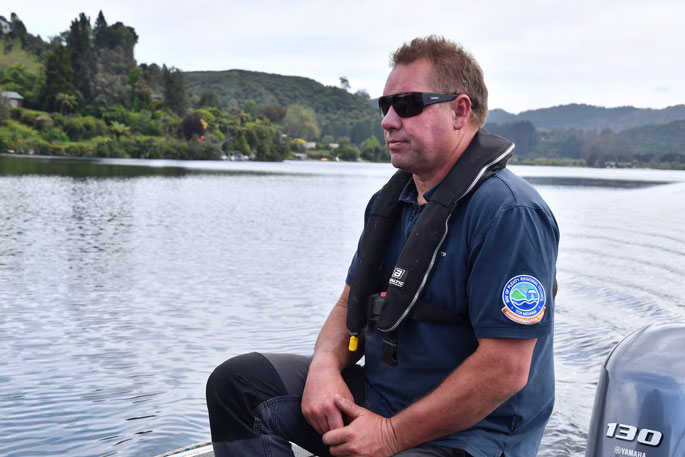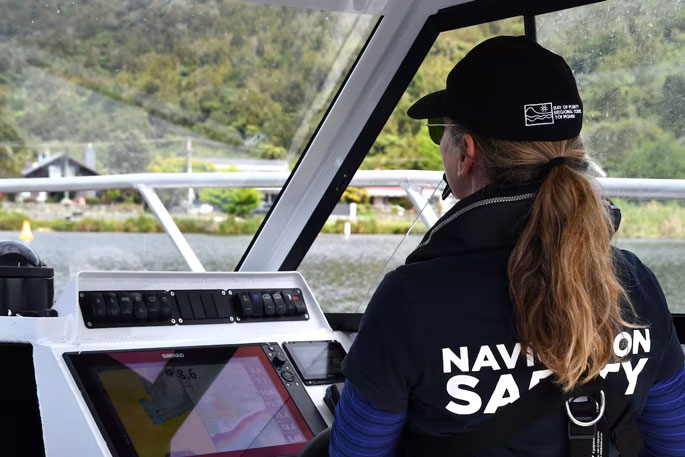The team who enforce rules on the water in the Bay of Plenty are anticipating a busy few months after dishing out 150 infringements last summer.
The region’s harbourmaster and maritime team are also emphasising lifejacket rules after a series of water deaths around the country prior to the holiday period.
Lakes senior maritime officer Roly Bagshaw said he was anticipating another busy summer for boating in the Bay.
The former Tauranga Sport Fishing Club manager has been with the Bay of Plenty Regional Council for four years and recently took Local Democracy Reporting on a trip to Lake Ōkāreka in Rotorua to go over some of the work he and the team do.
He hoped educating boaties would be easier this summer than in other years.
“We’ve gone through Covid-19 where everyone was buying a boat ... we were on this major education drive to get everyone up to speed.”
There were a couple years of thinking “this is crazy”, he said, with many more people out on the lakes who did not know the rules or have the right skills.
Things improved last year, Bagshaw said.
The maritime team began their regular patrols after Labour Day and these involved making sure harbour and lake users knew the rules.
He said improving boaties’ water safety skills was his favourite part of the job.
“I think after people talk to our patrol they come away with a greater understanding and operate more safely.
 Bay of Plenty Regional Council lakes senior maritime officer Roly Bagshaw on Lake Ōkāreka. Photo / Laura Smith
Bay of Plenty Regional Council lakes senior maritime officer Roly Bagshaw on Lake Ōkāreka. Photo / Laura Smith
“That’s a nice feeling.”
Things patrols looked for included vessels sticking to speed limits such as 5 knots within 200m of the shore, and kept clear of swim-only zones.
Both of these were relevant to Ōkāreka, with the first 600m of Acacia Bay being a 5-knot limit and a swim-only zone at Boyes Beach.
He said it gave the many passive lake users “a nice buffer zone”.
“That might be people swimming or in kayaks and stand-up paddleboarding, which is really popular now.
Bagshaw said wearing a lifejacket was something the team could not stress enough and was a heavy focus of the patrols.
The present law required boats to have lifejackets on board of the correct size and type, while an incoming council rule change – subject to Ministry of Transport approval – meant lifejackets must be worn in vessels under 6m while under way.
 The Bay of Plenty Regional Council harbourmaster and maritime team ensure rules like boat speed and keeping clear of swimming areas are adhered to. Photo / Laura Smith
The Bay of Plenty Regional Council harbourmaster and maritime team ensure rules like boat speed and keeping clear of swimming areas are adhered to. Photo / Laura Smith
Bagshaw said the rules were important.
“We’ve seen a number of fatalities on the lakes in the last few years and really don’t want to see anything else.”
It was great to see children wearing lifejackets, he said.
“It’s all just about going home to our loved ones at the end of the day after enjoying these amazing scenes.”
Bagshaw said it was important people read the signage at boat ramps and “know before you go”.
Harbourmaster Jon Jon Peters presented the team’s annual report in June.
“Summer in the Bay of Plenty is extremely busy for our maritime team with visitors and locals alike using our rivers, harbours and coastal waters.”
Last summer’s initiatives were delivered by 30 patrol crews and five students on board six vessels, and at boat ramps across the region.
The team completed 520 on-water patrols, producing 400 bylaw breaches and 150 infringements.
“Data gathered from the 1150 surveys completed help us paint a picture while informing and measuring our recreational craft harm prevention work and related compliance activities, allowing evidence-based decision-making for next season.”
In a December statement to Local Democracy Reporting, he emphasised safety messages after a series of drownings and water-related incidents in the lead-up to the holiday season, including four in 24 hours nationwide.
One of these included a man who leapt from a boat into the water off Whakatāne and could not be revived.
“Following the tragic drownings around the country in the weekend, we would like to reiterate Water Safety’s message that people need to stay safe and be cautious around water.
“From a boating perspective that includes checking the tides and weather before you head out and most importantly, wearing a lifejacket.’
According to Water Safety New Zealand, of the 90 people who drowned last year, five were in the Bay of Plenty. None related to boating. The 10-year average was 7.7 drownings a year.
 The Bay of Plenty Regional Council harbourmaster and maritime team ensure rules like boat speed and keeping clear of swimming areas are adhered to. Photo / Laura Smith
The Bay of Plenty Regional Council harbourmaster and maritime team ensure rules like boat speed and keeping clear of swimming areas are adhered to. Photo / Laura Smith
Preliminary 2024 data recorded 67 drownings nationally as of mid-December.
Water Safety New Zealand chief executive Daniel Gerrard previously told Local Democracy Reporting the importance of a lifejacket could not be overstated.
Of 14 watercraft-related deaths in the first nine months of this year, 13 had not worn lifejackets.
“Wearing a lifejacket significantly increases your chances of survival, and it is a simple step that can save lives.”
He praised the regional council for its rule change and said it was a critical measure to reducing drowning fatalities.
LDR is local body journalism co-funded by RNZ and NZ On Air.




0 comments
Leave a Comment
You must be logged in to make a comment.